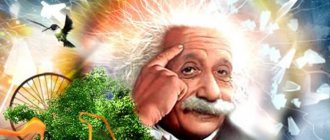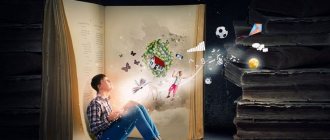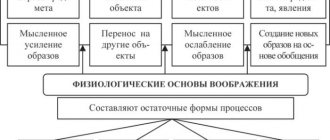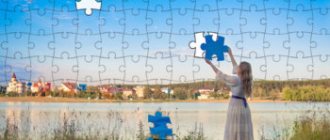What is imagination
By definition, imagination in psychology is a process in which images appear in the subconscious that are closely related to life experience, fantasy and way of thinking. It helps to imagine the consequences of certain actions, as well as outline a plan of action in an unclear situation.
According to scientists, imagination is one of the types of brain activity in which new additional neural connections are formed. We can also say that this is a process of transforming reality, creating images associated with it, processing the resulting practical, intellectual and sensory experience. These images are bright, original and at the same time truthful.
Imagination can be called a way of understanding the world around us. It leaves an imprint on our consciousness. Thanks to this, you can not only replay what happened recently, but also imagine what will happen in the future. You have the opportunity to imagine non-existent or absent objects and mentally use them in your consciousness.
It is interesting that even the most pragmatic, skeptical people have imagination. They may live by logic, ironclad principles and rules, but will still dream or think creatively.
Purpose and functions
The role of imagination is represented by the following points:
- the ability to represent reality using images, the ability to use them;
- in an unforeseen event, an individual can form a plan of action;
- the ability to regulate the emotionality of relationships;
- regulation of individual cognition processes.
Imagination allows one to go beyond the limits of human understanding, helps to foresee the future, and brings the past to life.
I bring to your attention the functions of imagination.
- Encouraging active activity with the help of an attractive, vivid image of the result.
- The presence of certain plans and ways of implementing plans.
- Psychotherapy, emotional self-regulation, illusory satisfaction of one's needs. Based on this feature, there is a risk of losing reality. A particular example of replacing reality with images from games, a consequence of gambling addiction.
- The ability to regulate one’s behavior in non-standard situations, sometimes problematic, with the help of alternative actions, new images, taking into account possible consequences.
- Organization of cognition, modeling, reconstruction of objects according to a detailed description, completion of missing elements.
Functions of the imagination
The importance of imagination is difficult to overestimate. Like any other mental process, it has a number of functions:
- Cognitive. This is a function of both thinking and imagination. Helps broaden your horizons, obtain new information and knowledge, and draw up a plan of action in an unfamiliar situation. Teaches a person to be guided by guesses, reasoning and considerations.
- Prediction function. A person can imagine what will follow his actions. This type of imagination is involved in the formation of dreams and daydreams.
- Understanding. It manifests itself in the ability to assume what another person feels and experiences in a given situation, what emotions and sensations he or she has now. This type of imagination is somewhat similar to empathy. It allows you to look into the inner world of your interlocutor and understand what worries him at the moment.
- Protection. When a person plays out a situation in his mind, a possible outcome of events or the consequences of his actions, he can prevent troubles and protect himself from problems.
- Self-development. This function of imagination helps to fantasize, come up with something new, and create.
- Memories. Images from the past emerge in the subconscious.
Not every person has all the functions of the imagination. Their set depends on character, behavior, personal qualities.
Passive
Passive (involuntary) imagination means the emergence of images that does not require conscious effort from a person .
With weakened conscious control, they arise by themselves, without a person’s volitional effort.
The source of their occurrence is not a logical connection and a person’s awareness of reality.
The passive images that arise often serve as a reflection of his internal state, fears, aspirations, desires, and speak about the personal needs of the individual.
Involuntary imagination is often not subject to logical comprehension, often representing a combination of completely contradictory images.
It is also often difficult to verbalize it after the experience, since such images are often symbolic, abstract and incomprehensible to other people.
Passive imagination is governed by two basic principles:
- Each affect strives to preserve , exaggerating the subjective logical value of ideas. Thus, a cheerful person will more often have positive images, and a sad person, on the contrary, will have sad ones.
- A person strives to preserve pleasant experiences , and, therefore, pleasant images that have arisen.
Types of imagination
The most basic types of human imagination are passive and active. Each of them is divided into subgroups. Among them are voluntary, involuntary, creative, reproductive imagination, etc. Let's take a closer look.
Passive
Such imagination may have a purpose. It can be regulated and directed using consciousness and willpower. It can also be involuntary, that is, working at the subconscious level.
Operations of imagination have varying degrees of awareness and unconsciousness. You've probably also encountered a state where thoughts fly through your head one after another. Along with them, some images and pictures appear. They replace each other until something interests you. At this moment, awareness turns on. You begin to control the process. In addition, you become aware of the line between reality and the fictional world.
In the case of the involuntary variety of imagination, everything happens spontaneously, uncontrollably. You don't have images and associations.
In psychology, dreams and hallucinations are classified as passive involuntary types of imagination:
- Dreams are the result of a healthy psyche. This is a combination of inhibition and excitation processes occurring in the cerebral cortex. During braking, the subconscious comes into play, which stores a huge amount of various information. For example, remember the children's toy kaleidoscope. So, images and associations from the subconscious are mixed and intertwined, as a result of which colorful and sometimes unusual dreams appear.
- Hallucinations occur when the functioning of the cerebral cortex is disrupted. They often occur in cases of serious illness, excessive consumption of alcoholic beverages or drugs, or mental disorders. It also happens that they are a consequence of emotional overexcitation, a state when a person is unable to control himself.
The main property of both types is the inability to control them.
Passive voluntary types of imagination can be controlled. Most of them are related to forecasts for the future. A person predicts the probable, unlikely and completely incredible outcome of events. In this case, you don’t have to limit your imagination.
Passive voluntary imagination has 2 forms:
- Daydreaming is not just a way to fantasize. This is an opportunity to recreate images of the future. And, what’s most interesting, they are quite feasible. The main property of such imagination in psychology is to encourage a person to take active action, to coordinate his actions in the direction of his dreams.
- Dreams have nothing to do with reality. This is an illusion, a figment of the imagination, something that cannot be realized.
Sometimes it is difficult to see the line between dreams and daydreams. For clarity, let's give an example. Imagine a girl reading an exciting novel. According to the plot, three young men fall in love with the main character. If a girl also wants to be in such a situation, this is a dream. And if she wants to write and publish an equally exciting story, this is a dream come true.
Active
Active voluntary imagination is the most significant thing in a person’s life. It is used in almost all areas of life. Helps to recreate images from the subconscious in reality.
According to the classification of types of imagination, active is divided into 2 subtypes: reproductive and creative.
Imagination and creativity are closely related. Creative imagination is considered the highest form of all cognitive processes. It helps in creating both fantastic and very real images. Take, for example, painting realistic landscapes or literary works. This type of imagination plays a special role in science, the work of designers, etc. One might even say that it is involved in almost all areas of life.
The creative imagination has another interesting feature. It helps you see a situation from different angles, generate unusual ideas and make innovative decisions.
In psychology, this type of imagination is associated with inspiration, the subconscious, and intuition. A lot of creative imagination techniques have also been developed, the use of which helps to increase productivity and make your activities more interesting and exciting.
Reproductive imagination is also called re-creative. It is used when you need to recreate images based on a ready-made description, diagram or drawing. What can you imagine? There are a number of examples:
- house according to the drawn up project;
- drawing connected according to a pattern;
- the hero whose description is given in the book;
- cake or other dish that will be prepared according to the recipe.
Recreative imagination has an interesting characteristic. All images are based on what a person already knows. Take, for example, the house project described above. Only a person who has special knowledge and skills can understand it.
Imagination its types and forms
CONTENT:
Introduction………………………………………………………………………………….2
- General characteristics of imagination…………………………….3
- Ways to create images of the imagination…………………………6
- Types and forms of imagination……………………………………………………….9
Conclusion…………………………………………………………….12
List of references……………………………..13
INTRODUCTION.
Man constantly comes into contact with his environment. Every second our senses are affected by dozens and hundreds of different stimuli, many of which remain in human memory for a long time. Moreover, one of the most curious phenomena of the human psyche is that the impressions received in previous practice from objects and phenomena of the real world are not only stored in memory for a long time, but are also subject to certain processing. The existence of this phenomenon has made it possible for humans to influence the environment and purposefully change it.
It should be noted that the impact of an animal on the external environment and changes in the external environment by humans have fundamental differences. Unlike an animal, a person influences the environment systematically, directing his efforts towards a predetermined goal. This nature of the change in reality in the process of labor presupposes a preliminary representation in the mind of what a person wants to receive as a result of his activity. For example, a spider performs certain operations that resemble those of a weaver, and bees, in the construction of their wax cells, resemble human builders. However, any worst specialist differs from the best bee or the most skillful spider in that he acts according to a pre-planned plan. Any work involves the development of such a plan, and only then its implementation in practice.
Thus, considering the process of a person creating something new, we are faced with another phenomenon of the human psyche. His
The essence is that a person creates an image in his mind that does not yet exist in reality, and the basis for creating such an image is our past experience, which we received by interacting with objective reality. It is this process - the process of creating new mental images - that is called imagination.
1. General characteristics of imagination.
Imagination is the process of transforming ideas that reflect reality, and creating new ideas on this basis. The process of imagination is unique to man and is a necessary condition for his work activity. Imagination is always directed towards the practical activities of man. Before doing anything, a person imagines what needs to be done and how he will do it. Thus, he already creates in advance the image of a material thing that will be manufactured in the subsequent practical activity of man. This ability of a person to imagine in advance the final result of his work, as well as the process of creating a material thing, sharply distinguishes human activity from the “activity” of animals, sometimes very skillful.
The physiological basis of imagination is the formation of new combinations from those temporary connections that have already been formed in past experience. At the same time, simple updating of existing temporary connections does not yet lead to the creation of a new one. The creation of a new one presupposes a combination that is formed from temporary connections that have not previously been combined with each other. In this case, the second signal system, the word, is important. The process of imagination is a joint work of both signaling systems. All visual images are inextricably linked with him. As a rule, the word serves as a source of the appearance of images of the imagination, controls the path of their formation, and is a means of retaining, consolidating, and changing them.
Imagination is always a certain departure from reality. But in any case, the source of imagination is objective reality. Imagination is the figurative construction of the content of a concept about an object (or the design of a scheme of actions with it) even before the concept itself is formed (and the scheme receives a clear, verifiable and implemented expression in specific material).
What is characteristic of imagination is that knowledge has not yet formed into a logical category, while a peculiar correlation of the universal and the individual at the sensory level has already been made. Thanks to this, in the very act of contemplation, a separate fact is revealed in its universal perspective, revealing its integral meaning in relation to a certain situation. Therefore, in terms of imagination, a holistic image of the situation is built before a dismembered and detailed picture of what is contemplated.
It is generally accepted that imagination arose in the process of labor - a specifically human activity, due to the existence of a need to transform objects of the real world. For example, having before his eyes a tool of labor that was not entirely perfect in its characteristics and properties, a person could imagine another tool that corresponds to his idea of what is necessary to perform a particular labor operation. But then, in the course of the historical development of man, the activity of the imagination began to manifest itself not only in work, but also in the fantasies and dreams of man, that is, in images that could not be created in practice at the moment. Extremely complex forms of imagination have appeared, necessary in scientific, technical and artistic creativity. However, even in these cases, imagination appears as the result of the transformation of our ideas obtained from reality.
It should be noted that imaginary images are created only by processing individual aspects of a person’s existing images of reality. For example, while reading science fiction novels, you probably noticed that fictional characters (aliens, monsters, non-existent animals, etc.) are still completely or partially similar in appearance to objects known to us, i.e. they were transformed by the writer’s imagination from real reality.
The activity of imagination is closely related to thinking.
By orienting a person in the process of activity, imagination creates a psychological model of the final and intermediate results of work and thereby ensures the embodiment of the ideal image into a material or ideal product.
The value of imagination lies in the fact that it helps a person navigate problem situations, make the right decisions, and foresee the results of his actions in conditions where knowledge is not enough to directly implement a cognitive need. Thanks to imagination, effective human behavior and activity becomes possible in conditions of incomplete information.
2. Ways to create images of the imagination.
Images recreated in the process of imagination cannot arise out of nothing. They are formed on the basis of our previous experience, on the basis of ideas about objects and phenomena of objective reality. The process of creating imaginary images from impressions received by a person from reality can occur in various forms.
The creation of imaginary images goes through two main stages. At the first stage, a kind of division of impressions, or existing ideas, into their component parts occurs. In other words, the first stage of the formation of imaginative images is characterized by analysis
impressions received from reality or ideas formed as a result of previous experience.
During such an analysis, the object is abstracted
, i.e., it appears to us isolated from other objects, and parts of the object are also abstracted.
With these images, transformations of two main types can then be carried out. Firstly, these images can be put into new combinations and connections. Secondly, these images can be given a completely new meaning. In any case, operations are performed with abstracted images that can be characterized as synthesis.
These operations, which constitute the essence of the synthesizing activity of the imagination, are the second stage in the formation of imaginative images. Moreover, the forms in which the synthesizing activity of the imagination is carried out are extremely diverse.
The simplest form of synthesis in the process of imagination is agglutination,
that is, the creation of a new image by attaching in the imagination parts or properties of one object to another. Examples of agglutination include: the image of a centaur, the image of a winged man in the drawings of North American Indians, the image of an ancient Egyptian deity (a man with a tail and an animal head), etc.
Agglutination is widely used in art and technical creativity. For example, everyone knows the advice that Leonardo da Vinci gave to young artists: “If you want to make a fictional animal seem natural - let it be, say, a snake - then take for its head the head of a shepherd or a gun dog, adding cat eyes to it , the ears of an eagle owl, the nose of a greyhound, the eyebrows of a lion, the temples of an old rooster and the neck of a water turtle.” In technology, as a result of the use of agglutination, for example, an amphibious vehicle and a hovercraft were created.
One of the most common ways of processing images of perception into images of imagination is to increase
or
reduction of an object or its parts.
Various literary characters have been created using this method.
Agglutination can also be carried out by incorporating already known images into a new context.
In this case, new connections are established between ideas, thanks to which the entire set of images receives a new meaning. Typically, when introducing ideas into a new context, the process is preceded by a specific idea or goal. This process is completely controllable, unless it is a dream, when control of consciousness is impossible. When incorporating already known images into a new context, a person achieves correspondence between individual ideas and the holistic context. Therefore, the entire process is subordinated to certain meaningful connections from the very beginning.
The most significant ways of processing ideas into images of the imagination, following the path of generalization of essential features, are schematization
and
accent.
Schematization can occur under different conditions. Firstly, schematization can arise as a result of an incomplete, superficial perception of an object. In this case, the representations are schematized randomly, and they sometimes highlight minor details that were accidentally discovered during the perception of the object. As a result, distortions arise that lead to the creation of imaginary images that distort reality. A similar phenomenon often occurs in children.
Secondly, the reason for schematization in the case of a sufficiently complete perception of the object may be the forgetting of any unimportant details or parts. In this case, significant details and features come to the fore in the presentation. At the same time, the representation loses some individuality and becomes more generalized.
And finally, thirdly, the reason for schematization may be a conscious distraction from unimportant, or secondary, aspects of the object. A person consciously directs his attention to the essential, in his opinion, features and properties of an object and, as a result, reduces ideas to a certain scheme.
Emphasis is to emphasize the most significant, typical features of the image. As a rule, this method is used when creating artistic images. The main feature of this processing of images of perception into images of imagination is that, reflecting real reality and typifying it, an artistic image always gives a broad generalization, but this generalization is always reflected in a specific image. Moreover, the processing of ideas when creating a typical image is not accomplished by mechanical addition or subtraction of any features. The process of creating a typical image is a complex creative process and reflects certain individual characteristics of the person creating this image.
3. Types and forms of imagination.
The activity of the imagination can be characterized in terms of participation in this process of volitional regulation, depending on the nature of the activity and the content of the images created.
Depending on the participation of will and activity, imagination is divided into voluntary
and
involuntary
.
Involuntary is an imagination when the creation of new images is not based on a special goal. The involuntary emergence of ideas is closely related to a person’s feelings. An extreme case of involuntary imagination is dreams,
in which images are born unintentionally and in the most unexpected and bizarre combinations.
The process of imagination can be arbitrary when it is directed with the special purpose of creating an image of a certain object, a possible situation, imagining or foreseeing a scenario for the development of events. The arbitrary creation of images takes place mainly in human creative activity.
Depending on the nature of a person’s activity, his imagination is divided into creative
and
reproductive
.
Imagination, which is included in creative activity and helps a person create new original images, is called creative.
Imagination, which is included in the process of mastering what other people have already created or described, is called reproducing or reproductive.
Thus, a designer-inventor who creates a new machine has a creative imagination, while an engineer who creates an image of a machine from verbal descriptions or a drawing has a reproductive imagination.
An important role in creative imagination is played by language, which is a way of understanding the creative concept and a tool of analytical and synthetic activity.
Reproductive imagination is the process of a person creating images of new objects based on their verbal description or graphic image.
Depending on the content of the activity, imagination is divided into technical, scientific, artistic and other types related to the nature of a person’s work.
The artistic imagination has predominantly sensual images, extremely vivid and detailed.
Technical imagination is characterized by the creation of images of spatial relationships in the form of geometric figures and structures, their easy dissociation and combination into new connections, and their mental transfer to different situations.
Images of technical imagination are most often combined in drawings and diagrams, on the basis of which new machines and new objects are then created.
Scientific imagination finds its expression in constructing hypotheses, conducting experiments, and developing generalizations carried out in the creation of concepts. Fantasy plays an important role in planning scientific research, in constructing an experimental situation, and in making predictions during an experiment.
A special form of imagination is a dream.
A dream is the process of a person creating images of a desirable future.
Dreams can be real, effective and unreal, fruitless. The effectiveness of a dream is a necessary condition for the implementation of a person’s creative plans aimed at truly transforming reality. Such dreams, in a certain understanding, are the driving force behind a person’s actions and deeds, helping him set goals, deal with difficulties, and resist adverse influences.
Dreams can be empty and fruitless. Then they disorient a person, deprive him of a vision of real life prospects, and make him unable to withstand the difficulties of real life.
Only an active, creative dream has a positive impact on a person’s life; it enriches a person’s life, makes it bright and interesting.
CONCLUSION
It should be noted that along with perception, memory and thinking, imagination plays an important role in human activity. The process of imagination is unique to man and is a necessary condition for his work activity.
Imagination significantly expands and deepens the process of cognition. It also plays a huge role in transforming the objective world. Before changing something practically, a person changes it mentally.
Images of the imagination do not always correspond to reality; they contain elements of fantasy and fiction. If the imagination draws pictures to the consciousness that nothing or little corresponds in reality, then it is called fantasy. If the imagination is directed to the future, it is called a dream. The process of imagination always occurs in inextricable connection with two other mental processes - memory and thinking.
The formation of a number of moral and psychological qualities of a person is associated with the activity of imagination - humanity, sensitivity, sense of duty, etc.
Functions of imagination: creating new images - a leading reflection of reality.
Mechanisms of imagination: dissociation of impressions and elements into new combinations.
Bibliography:
1. Maklakov A. G. General psychology. - St. Petersburg: Peter, 2001. - 592 p.: ill. — (Series “Textbook of the New Century”)
2. Maksimenko S.D. General psychology. – M.: 2004, ed. "Refl-book".
3. General psychology: Textbook. for pedagogical students Institute / Ed. A.V. Petrovsky. 2nd ed., add. and processed M., 1976. 479 p.
4. Rubinshtein S.L. Fundamentals of general psychology. T.1. -M.: 1989.
Creating images
A person creates images in the imagination in several ways:
- Agglutination. The qualities and parts of individual objects are combined into a single whole. Examples: centaur, fairy-tale hut on chicken legs, seaplane, snowmobile.
- Emphasis. Part of the object is divided into separate parts. A good example is caricatures in which the artist highlights a certain feature.
- Hyperbolization. Involves reducing, enlarging, or shifting individual parts of the selected object. Here you can also remember fairy tales, for example, about dragons with several heads.
Another way to create images in the imagination is typification. It is considered the most difficult. Imagine any picture. Contemplating it, you draw in your subconscious the image that the artist conveyed. Or take, for example, a book. The author describes in it the features of the main character. Thanks to this, you can imagine how he looks, thinks, behaves. It is as if you are transported into the world around him.
What does imagination give to a person?
So, we found out what imagination is and what functions it plays. But why do you need it personally? There are several points:
- helps in communicating with other people;
- makes it possible to visualize the goal;
- promotes the development of creative talents;
- participates in decision making and creation of new ideas;
- helps you mentally recreate an image of an object or phenomenon that you have never seen.
Plus, imagination is used in making predictions and action plans for the future. It is needed in all areas of activity, especially in those that cannot be fully automated. We are talking about design, research work.
Does a child need imagination? The answer is clear: yes. Without it, full development is impossible. The first few years of a child's life explore the world around him. And if for some reason his imagination does not work at full strength, the formation of important abilities is inhibited.
The imagination developed in childhood will help an adult to become creative in the future, develop creative skills, and learn to find an unusual way out of a difficult situation. And this will be useful in life.
Definition of imagination
Imagination is a special form of the psyche that only a person can have. It is constantly connected to the human ability to change the world, transform reality and create something new. M. Gorky was right when he said that “this is an invention that elevates man above animals,” because only man, as a social being, rebuilding the world, develops real imagination.
With a rich imagination, a person can live in different times, which no other creature in the world can do. The past is recorded in memory images, the future is represented in dreams and fantasies.
Each imagination produces something new, changes, transforms what is given by perception. These changes and transformations can manifest themselves in such a way that a person, based on knowledge and on the basis of his experience, imagines something, i.e. forms a picture of something he has never seen in reality. For example, information about a flight into space stimulates our imagination to paint pictures of a fantastic and unusual life in zero gravity, surrounded by stars and planets.
Imagination, foreseeing the future, can create an image, a picture of something that has not yet existed. Thus, astronauts could imagine in their minds going into space and landing on the moon when it was just a dream, not yet realized and not known to be feasible.
After all, fantasy can also make such a deviation from reality that it creates a fantastic image that is strikingly different from reality. But in this case it also reflects this reality to some extent. And the imagination is all the more fruitful and valuable the more it, while changing reality and deviating from it, still takes into account its essential aspects and most significant features.
To study the cognitive role of imagination, it is necessary to clarify its features and determine its real nature. In the scientific literature there are many approaches to defining imagination. Let's look at some of them and define the main features of imagination.
S.L. Rubinstein writes: “Imagination is an escape from past experience, it is the transformation of data and the generation of new images on this basis.”
L.S. Vygotsky believes that “the imagination does not repeat previously collected impressions, but builds new series from previously collected impressions.” Thus, the introduction of new impressions into our impressions and the change of these impressions in such a way that the result is the formation of a new, previously non-existent image, forms the basis of that activity which we call fantasy.”
According to E.I. Ignatiev, “the main feature of the imagination process is the transformation and processing of data and materials from past experience, resulting in the formation of a new image.”
And the “Dictionary of Philosophy” defines imagination as “the ability to create new sensory or mental images in a person’s mind based on the transformation of impressions received from reality.”
As can be seen from the definitions, an essential characteristic of imagination is the subject’s ability to create new images. But this is not enough, because then it is impossible to distinguish between imagination and thinking. After all, human thinking cannot simply be identified with imagination, because the creation of new knowledge and concepts can occur without the participation of imagination.
Many researchers note that imagination is the process of creating new images that occurs at the visual level. This tendency associates imagination with forms of sensory reflection, while another believes that imagination generates not only new sensory images, but also new thoughts.
One of the characteristic features of imagination is that it is associated not only with thought, but also with sensory data. There is no imagination without thought, but it cannot be reduced to logic, because it is always associated with the transformation of sensory material.
Thus, it is obvious that imagination is both the creation of new images and the transformation of past experiences, and that this transformation is carried out in the organic unity of the sensory and rational.
How to develop your imagination
Psychologists have identified a number of techniques for developing imagination.
In adults
The main thing is to be ready to experiment, not to be shy and not afraid of mistakes. There are many ways:
- Visualization. You need to mentally reproduce the appearance of an object, location or action. Start with simple tasks. For example, look at what lies in front of you. Then close your eyes and imagine this object in detail.
- Reading. This method is related to the previous one. Visualization is also needed here. It's just much more difficult to make it. You will have to remember several characters, images, landscapes at once. And after that, look at their participation in the plot. All this will help you see the full picture. And by the way, reading is much more interesting than watching movies. In the case of reading, no one limits your imagination and imagination.
- Associations. Every adult has associative thinking. Most likely, when you hear the word “green,” you think of grass and trees. And with the word “orange” - about an orange.
- Creation of unusual animals. This is a great way to develop your creative imagination. Let it be, for example, a cat dog. Of course, they don’t talk about it in a biology textbook. But you'll have fun. This exercise is suitable for both adults and children.
- Art. Exhibitions or master classes will make up for the lack of imagination. By observing other people, you yourself can easily create an unusual idea or at least get inspired.
- "Box". Here you will have to take an example from the cartoon character SpongeBob. Remember your favorite activity? He sat in the box and turned on his imagination. No, don't think that you need to do the same. Although children can try. Walk into an empty room and mentally design the interior. Next time, rearrange it, etc. This way you will improve your imagination and perception.
Another way is role-playing games. You control the hero, while observing certain requirements and conditions. Games can be tabletop or real. The latter include quests.
In children
It's a little easier with children. They already love to fantasize, often coming up with unusual stories and even imagining imaginary friends next to them.
How to develop children's imagination?
- Read fairy tales, fantasy stories. Try to read, for example, to the middle. And then invite the child to continue the story.
- Observe the people around you. Let the child think about how someone lives along the way. If you can’t go outside, use photographs or ordinary pictures. This way you can help develop the imagination of both preschoolers and older children.
- Go to exhibitions together, visit museums, cinemas.
- Get creative together. Model from clay and plasticine, make appliqués, draw, assemble car models, etc.
As with adults, role-playing games with parents or peers help children develop their imagination.
Development
Creativity is best for developing imagination
If you intend to develop your imagination, then you can resort to the following tips.
- Engage in intellectual activities. A person must develop creatively and engage in scientific activities.
- Learn to think creatively.
- Become more emotional, develop empathy.
- Enrich your perceptual experience.
- Think through your actions, consider possible results.
- Try to fantasize more often, imagine what your life would be like if significant changes occurred at a certain moment.
- If you have children, write fairy tales for them.
- Engage in spontaneous creativity, learn to create using various materials.
Now you know what the development of imagination is. A person must understand that this ability helps to better navigate the world, be creative, and have a non-standard view of familiar things. You need to develop imagination in children and in yourself, learn to plan your steps, imagining possible results.
Example from life
I enjoy reading. Imagination helps you immerse yourself in the story. Even seemingly tedious descriptions of the area become much more interesting. I try to see the landscape through the eyes of the author, hear sounds, feel the wind or the scent of flowers.
The same goes for heroes. I try to imagine not only their appearance, but to monitor how their behavior and thinking changes in different situations. Thanks to this, after reading the book, it seems that I have visited this book world.










